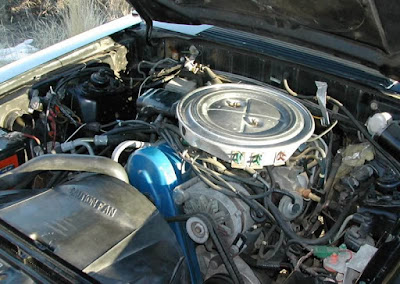1979 Ford Mustang Turbo - Ford best history
Put everything you've learned about Mustangs in the inactive
file. It's all ancient history now. Ford, with an enthusiasm Katy-bar-the-door
and a commitment too long missing in Dearborn, Ford has built the best yet.
Although the new Mustang is a fairly radical departure from
its ancestors, it was not a rapid accumulation manipulated to take advantage of
rapidly changing market trends, or to comply with any requirement of federal
fuel economy mandate. It came to life in the normal period of five years of gestation.
In other words, the wily old FoMoCo was endorsing outside LTD wonders like IIs
and reduced T-Birds, who knew very well what he had in store for 1979.
Ford engineers who spoke at the press introduction this
summer said management had issued from the first day that the new Mustang would
have the best management of any Ford production ever, and it would look good,
go quickly, and leave as it should. A true European leitmotif was established.
I got the impression that there had been so many smiling project engineers from
around Ford racing programs at Le Mans and Trans Am were.
There are two available body styles-sedan and hatchback of
four engines and three suspensions. Every Mustang comes with full
instrumentation, and although there is a tendency to sticky in the style of the
numbers on the dial faces, labeling is legible and dials are well placed. The
controls for wipers, washers, lights, horn, turn signals and column stalks they
are easy to reach and operate. The instrument panel, of course, is an extension
of fake wood, but is only moderately offensive. (In fact, the Department of
petro-Wood Ford is one of the best in Detroit.) An optional console contains a
lockable storage compartment no-Accord and a graphic display as revealing
information about various bulbs and fluid levels .
Total driver-passenger environment is quite good, with one
exception: the seats. There are two types of buckets available -the standard
units high back, and an additional cost, better-looking version lumbar. Nor
does it provide particularly good lateral support and softness promises some
muscle miseries of extended stay hotels. But worst of all, backups are not
adjustable for rake. (I counters Ford, beside himself, when they saw the free
hand of the designers of the Mustang were implemented, felt they had to
exercise some influence and decided to make their stand on the issue of the
seat back. His victory, however, may be short-lived. An engineer Mustang
confided that seat option Recaro is almost a "sure thing" for summer.
Take that, counters.) To be fair, I must admit that the fixed angle chosen for
the seats was quite good for my anatomical configuration.
The basic Mustang is a venerable 2.3-liter sedan carrying
OHC four-cylinder Ford, which is connected to a four-speed transmission. This
engine is a bit hard and busy as it goes about its business of not producing as
much energy. Get this engine if the economy is their aim.
The 2.8-liter V-6, together with a four-speed, is a good way
to equip its new Mustang. While the V-6 is not a tire burner, it does have the
respectable power (with relatively good fuel efficiency), and is not a heavy
piece of iron, as the V-8, sitting in front of screw distribution weight and
therefore their use.
The five-liter V-8 available for the Mustang is a torquey
beast-with considerable horsepower 1979: something around 150. In preliminary
tests was recorded zero to sixty time of 8.3 seconds and turned in fourth mile
race 17 seconds at 84.8 mph. The V-8 will not take you back to the old days of
muscle cars, but it will make you think about them. There is a trade-off, of
course. For that kind of straight line performance sacrificing handling. The
V-8 is heavy, and the best Mustang suspension can not quite cope with
understeer it creates.
Although a V-8 that performs like this is good news, the
turbo engine is News. Ford has mounted a turbo Garrett AiResearch the 2.3-liter
four-cylinder base, and with the extra help that the engine produces 132
horsepower, a good increase of 118. And is soft, discreet power of the standard
version. No increase broken neck when the turbo is doing its job: only a strong
pull as the revs climb and the motor is fed from its own emissions. In our
tests earlier this engine was good for-zero to sixty time of 9.1 seconds and
ran the quarter in 17.4 seconds at 82 mph.
Finally, there is the new suspension of the new Mustang,
available in three versions: Standard, management and TRX. Standard is
standard, which in this case is the version of Ford MacPherson struts at the
front, a four arms in the rear, and the springs and standard rate shocks. The
handling suspension uses radial tires, springs and dampers more
performance-oriented, and a rear stabilizer bar. The TRX suspension is designed
around the unique super-low profile tires of Michelin in the same appointment,
mounted on special forged aluminum wheels. The TRX system goes all the way with
a front bar, a bigger and special rear bar spring and shock rates. Not that I
ever worked. The TRX suspension is available on all 1979 Mustang Buy. It is
just wonderful.
Ford obviously has done a very good thing with his Mustang.
These cars not only what we have been asking are, are an indication of things
to come throughout the domestic industry. And that is good news.




Comments
Post a Comment